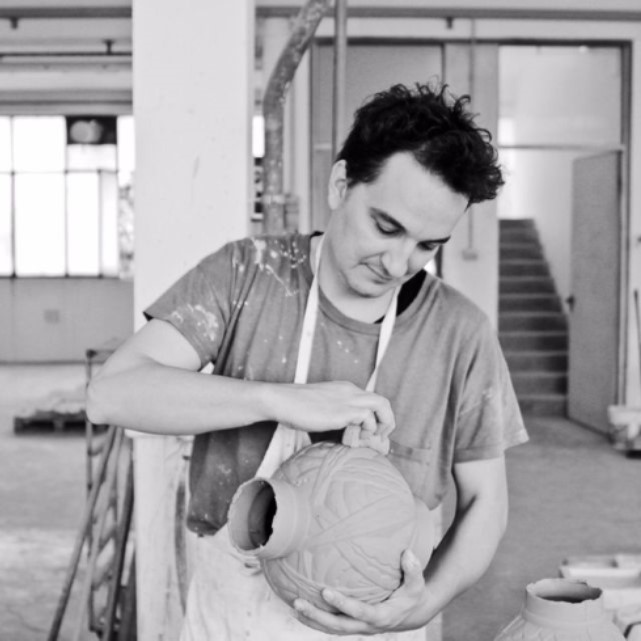
Present in our gallery since 2018.
Paolo Polloniato was born in Italy in 1979
He comes from a historic family of Master Craftsmen who have been linked for two centuries to the production of Nove ceramics, one of the most important centers in Italy. Between 2001 and 2007, he attended the course of Decoration section. B with professor Gaetano Mainenti, at the Academy of Fine Arts in Venice. In 2002 he co-founded the Made in Nove group. His research ranges through the use of different materials, chosen and dealt with according to the planned project and its aims. Since 2008, contemporary ceramics represents its fundamental research sector, developed through the revisitation of pictorial decoration and the manipulation of molds of the various historical manufactories of its place of origin, in order to create sculptures and conceptual installations in which a story relates to the present, generating new scenarios.
He has participated twice at the Ceramics Biennale in Vallarius twice, and three times at the International Ceramics Awards in Faenza. He was a finalist at the Prix European des Art Appliques in Mons, Belgium. He was invited to represent Italy at the European Ceramic Contest in Bornholm, Denmark. In 2014, he participated to the Design Art Basel in Miami with the Gallery Antonella Villanova of Florence. In 2016 he was invited to the Regia Venaria for the exhibition “Fatto in Italia. Dal Medievo al Made in Italy”, in the section dedicated to contemporary art. Among the most interesting projects have developed lately, he his particularly proud of the project
“Cristallino” with designer Cristina Celestino, for the Fuori Salone 2015 in Milan, for which he has made a limited edition project in ceramic and glass.
Families story
Paolo Polloniato was born near Venice that boasts a rich century-old ceramic tradition. Many members of his family have been master ceramists and maiolica decorators. Paolo was drawn to the history and heritage of his native land and to the family tradition and started making ceramics using the artisanal methods that craftsmen have used for centuries. His objects contain shapes and fragments of old pieces but are utterly contemporary, whimsical and delicate. In his production, artisanal techniques and old molds are used to create unexpectedly modern pieces that are true works of art.
…”What makes my objects special is the fact that they are created from different pieces of old objects. I create new shapes using fragments of the past. My objective is to conceptually and formally re-use old techniques to express contemporary concepts, while remaining truthful to traditions. To me to innovate means to recuperate and evolve. I start by going to several ateliers and historic workshops in my area, where I research molds belonging to different periods and styles spanning three centuries of ceramic tradition. Once I find the shapes that I like, I have raw clay models made and new molds made from them. I gather all the molds to my atelier and I start the decomposition of the different shapes. The following steps of installation, finish, and drying of the new piece are very delicate. Once completed, I bake the object at 1,000 degrees, then glaze it, and then bake it again at 980 degrees to give it its final finish. I was born into a family of master ceramists who started their production at the beginning of the 19th century in Nove. I studied at the Fine Arts Academy in Venice and subsequently started making ceramics. But the economic difficulties of my country upset me deeply: I knew that my choice of working in my native land on traditional artifacts wasn’t going to be easy. I moved for a few years to Paris and Brussels and in 2013 I came back home and started producing contemporary ceramics. My family has worked in Nove for the Manifattura Antinibon, now Barettoni, since the mid-19th century. Many members of my family worked there, including my father who was the last master decorator of maiolica. I chose to be on my own. I create my art collaborating with trusted artisans who help me in the crafting of both handmade pieces and those produced on a larger scale. The most important people in my company are the artisans with whom I collaborate and who support me in creating my projects. The history of the land where I was born and raised is the lifeblood of my research and the development of Nove’s traditions is the foundation of my work”.



